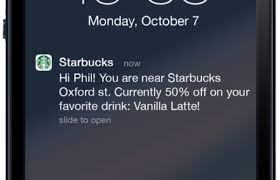Imagine you’re walking in the city center past one of your favorite stores, and right then a notification pops up on your phone saying that there is a discount on the jeans you searched for online last week. This is called proximity marketing (Gartner, n.d.), better known as location-based advertising. It uses user data on previous purchases, preferences, and search queries to offer the customer a personalized discount, at the right time and at the right location. This can be done by making use of different technologies, such as in-store WiFi networks, GPS, QR codes, NFC tags, and BLE beacons (AVSystem, 2022).
With consumers demanding more personalization in their shopping experience (Epsilon, 2018), location-based advertising can be useful to achieve that. It allows retailers to target their advertisements to specific customers, which results in higher profits for the retailer and in a more personalized experience for the customer. Another benefit that arises from its application is the collection of customer data for retailers. As the technology uses the customers’ location, retailers know exactly where a customer is located in the store and what shelves he or she passes and stops at.
Successful implementations have been achieved already. McDonalds in Turkey installed beacons in 15 McDonalds cafes, offering customers who were close by a coupon for a free coffee from their new drink line for free (Mittal, 2022). Starbucks also experimented with location-based advertising, already back in 2014. They send app-users advertisements when they were close to one of their stores, offering them a 50% discount on a drink (Simpson, 2016).
However, there are some concerns with regard to the privacy of customers (Inman and Nikolova, 2017). As their exact location is being tracked, retailers have a lot of information on their customers. Therefore it is important to explicitly send a notification to an app user that their location will be tracked to send them personalized advertisements, so they can opt-in first. Despite the possible privacy concerns, several studies showed that customers have a positive attitude toward location-based advertising. Banerjee and Dholakia (2008) found that personalized advertisements are more welcome in public environments than in private environments. This can be explained that customers benefit more from targeted advertisements in public locations, for example in front of the store they are about to enter to buy the item they wanted for a long time already. An advertisement at that moment is logically more welcome than the same offer when that person is making a phone call to his boss. Another study by Gazely et al. (2015) showed that location-based advertisements have a positive effect on purchase intent, adding that it is important that the advertisements are not perceived as intrusive. This shows the potential of location-based marketing. Retailers can better target customers, resulting in a higher conversion rate and higher revenues. Customers are provided with offers at the right time, and at the right location. This will benefit them more, as the offers are personalized and also based on their previous purchases and preferences, and as they are actually able to use the offers right away.
I personally strongly believe in the potential of this type of marketing. Both retailers and customers can greatly benefit from it, in terms of data and personalization. I am definitely willing to share my location to receive hyper-personalized offers on products that I am actually interested in, and I am very curious about what you think of it! Let me know below in the comments 🙂
Note: there are many more applications of location-based advertising than the one I discussed in this post. I hoped this sparked your interest at least!
References
AVSystem (February 3, 2022). 5 proximity marketing technologies you need to know. AVSystem – Shaping The World of Connected Devices. Available at: https://www.avsystem.com/blog/proximity-marketing/ (Accessed: 6 October 2022)
Banerjee, S., & Dholakia, R. R. (2008). Mobile advertising: Does location based advertising work? International Journal of Mobile Marketing.
Epsilon. (2018, January 9). New Epsilon research indicates 80% of consumers are more likely to make
a purchase when brands offer personalized experiences. Retrieved from www.epsilon.com:
https://www.epsilon.com/us/about-us/pressroom/new-epsilon-research-indicates-80-ofconsumers-are-more-likely-to-make-a-purchase-when-brands-offer-personalizedexperiences
Gartner (n.d.). Definition of proximity marketing – Gartner marketing glossary. Gartner. Available at: https://www.gartner.com/en/marketing/glossary/proximity-marketing (Accessed: 6 October 2022)
Gazley, A., Hunt, A., & McLaren, L. (2015). The effects of location-based services on consumer purchase intention at point of purchase. European Journal of Marketing, 1686-1708.
Inman, J., & Nikolova, H. (2017). Shopper-Facing Retail Technology: A Retailer Adoption Decision Framework Incorporating Shopper Attitudes and Privacy Concerns. Journal of Retailing, 7-28.
Mittal, S. (May 10, 2022). Proximity marketing examples: 28 retail companies nailing it with their campaigns. Available at: https://blog.beaconstac.com/2016/02/25-retailers-nailing-it-with-their-proximity-marketing-campaigns/ (Accessed: 6 October 2022).
Simpson, J. (January 18, 2016). What is location-based advertising & why is it the next big thing?. Econsultancy. Available at: https://econsultancy.com/what-is-location-based-advertising-why-is-it-the-next-big-thing/ (Accessed: 6 October 2022).




